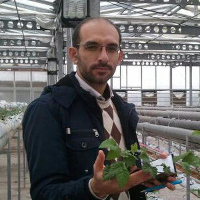Evaluation of storage temperature and container material effects on summer wild blackberry postharvest
Author(s):
Abstract:
Background And Objectives
Blackberry due to its short post-harvest shelf life and rapid perishability cannot be conserve for long time. Recently, using small plastic containers became popular that unfortunately is non-biodegradable and incompatible with environment so these materials are dangerous for environment. But using biodegradable packages which made up by natural materials like starch, corn, potato and wheat can be a suitable substitution. This research aimed to evaluate optimum conditions including temperature and container material for increasing summer wild blackberry shelf life.Materials And Methods
With the aim of evaluation of summer wild blackberry optimum storage conditions, its fruits were compared via three levels of temperature (0, 4 and 25˚C) and two kinds of containers (biodegradable and non-biodegradable) during 14 days. Different characteristics comprising of visual quality (fruit weight, fruit weight loss and market acceptance), edible quality (TSS, pH, TA, TSS/TA, flavor and taste) and health value (total antioxidant activity, total phenol content, total flavonoid content and total anthocyanin) was evaluated.Results
The obtained results showed fruits weight lost, during postharvest maintenance in all of treatments the highest fruit weight recorded on the first day and after that decreased significantly. In addition to fruit weight, length, width, flavor, taste and market acceptance of fruit decreased during storage, significantly. Visual quality of fruits packed in polystyrene container was better than bio based one. Total soluble solids of blackberries stored in biodegradable package were significantly higher than non-biodegradable container. Inhibitory percentage of DPPH radicals in all treatments showed powerful antioxidant properties of blackberry. The highest phenol content (62.33 gGalicacid/ g fruit juice) of fruits was recorded in 3th day at 4˚C in polystyrene container. The lowest amount of total phenol in the same temperature was observed after 8 days storage in biodegradable container. In both of containers, the temperature of 0 ˚C showed less decrease of flavonoid content. During the experiment conduction, anthocyanin content decreased generally but in 8 and 14th day in polystyrene container and 0˚C, its content increased from 224,99 in first day at 0oC to 57.89 and 90.3 mg Cyanidin/Lit fruit juice in both containers types at 14th day, significantly.Discussion
Water loss due to transpiration and respiration is the main reason for weight loss during post-harvest period. Because of this, using Nano particles in containers materials around the fruits to control water exchange can reduce weight loss and influence different fruit characteristics as well.Conclusion
The positive effect of the 0 ˚C temperature on blackberry shelf life was significant. Using biodegradable package despite its environmental importance showed less efficiency for increasing blackberry postharvest life in comparison with plastic one and require additional researches. Keywords:
Language:
Persian
Published:
Plant Production, Volume:40 Issue: 2, 2017
Pages:
99 to 112
magiran.com/p1739545
دانلود و مطالعه متن این مقاله با یکی از روشهای زیر امکان پذیر است:
اشتراک شخصی
با عضویت و پرداخت آنلاین حق اشتراک یکساله به مبلغ 1,390,000ريال میتوانید 70 عنوان مطلب دانلود کنید!
اشتراک سازمانی
به کتابخانه دانشگاه یا محل کار خود پیشنهاد کنید تا اشتراک سازمانی این پایگاه را برای دسترسی نامحدود همه کاربران به متن مطالب تهیه نمایند!
توجه!
- حق عضویت دریافتی صرف حمایت از نشریات عضو و نگهداری، تکمیل و توسعه مگیران میشود.
- پرداخت حق اشتراک و دانلود مقالات اجازه بازنشر آن در سایر رسانههای چاپی و دیجیتال را به کاربر نمیدهد.
In order to view content subscription is required
Personal subscription
Subscribe magiran.com for 70 € euros via PayPal and download 70 articles during a year.
Organization subscription
Please contact us to subscribe your university or library for unlimited access!



